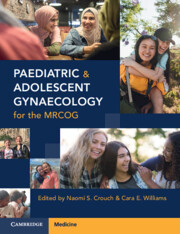Book contents
- Paediatric and Adolescent Gynaecology for the MRCOG
- Paediatric and Adolescent Gynaecology for the MRCOG
- Copyright page
- Contents
- Contributors
- Introduction
- Chapter 1 Embryological Development of the Internal and External Female Genitalia
- Chapter 2 Gynaecological History and Examination in Children and Adolescents
- Chapter 3 Normal and Precocious Puberty
- Chapter 4 Common Prepubertal Problems in Paediatric Gynaecology
- Chapter 5 Adolescent Menstrual Dysfunction
- Chapter 6 Polycystic Ovary Syndrome in Adolescence
- Chapter 7 Müllerian Duct Anomalies
- Chapter 8 Primary Amenorrhoea and Delayed Puberty
- Chapter 9 Rokitansky Syndrome
- Chapter 10 Turner Syndrome
- Chapter 11 Differences in Sex Development
- Chapter 12 Premature Ovarian Insufficiency
- Chapter 13 Gynaecological Laparoscopy in Adolescents
- Chapter 14 Psychology in Paediatric and Adolescent Gynaecology
- Chapter 15 Legal and Ethical Aspects of Paediatric and Adolescent Gynaecology
- Index
- References
Chapter 5 - Adolescent Menstrual Dysfunction
Published online by Cambridge University Press: 28 January 2023
- Paediatric and Adolescent Gynaecology for the MRCOG
- Paediatric and Adolescent Gynaecology for the MRCOG
- Copyright page
- Contents
- Contributors
- Introduction
- Chapter 1 Embryological Development of the Internal and External Female Genitalia
- Chapter 2 Gynaecological History and Examination in Children and Adolescents
- Chapter 3 Normal and Precocious Puberty
- Chapter 4 Common Prepubertal Problems in Paediatric Gynaecology
- Chapter 5 Adolescent Menstrual Dysfunction
- Chapter 6 Polycystic Ovary Syndrome in Adolescence
- Chapter 7 Müllerian Duct Anomalies
- Chapter 8 Primary Amenorrhoea and Delayed Puberty
- Chapter 9 Rokitansky Syndrome
- Chapter 10 Turner Syndrome
- Chapter 11 Differences in Sex Development
- Chapter 12 Premature Ovarian Insufficiency
- Chapter 13 Gynaecological Laparoscopy in Adolescents
- Chapter 14 Psychology in Paediatric and Adolescent Gynaecology
- Chapter 15 Legal and Ethical Aspects of Paediatric and Adolescent Gynaecology
- Index
- References
Summary
Menstrual disorders such as irregular, heavy or painful periods are common in adolescent girls and may affect quality of life, disrupt sports and social activities and are known to cause school absences in one in four girls. Immaturity of the hypothalamo–pituitary–ovarian (HPO) axis in post-menarchal years is the leading cause for menstrual dysfunction and visits to the emergency department in this age group [1]. Several terminologies have been used to describe menstrual dysfunction, but the International Federation of Gynaecology and Obstetrics (FIGO) system, describing normal and abnormal uterine bleeding (AUB) is the most universally preferred classification [2].
- Type
- Chapter
- Information
- Paediatric and Adolescent Gynaecology for the MRCOG , pp. 33 - 43Publisher: Cambridge University PressPrint publication year: 2023



